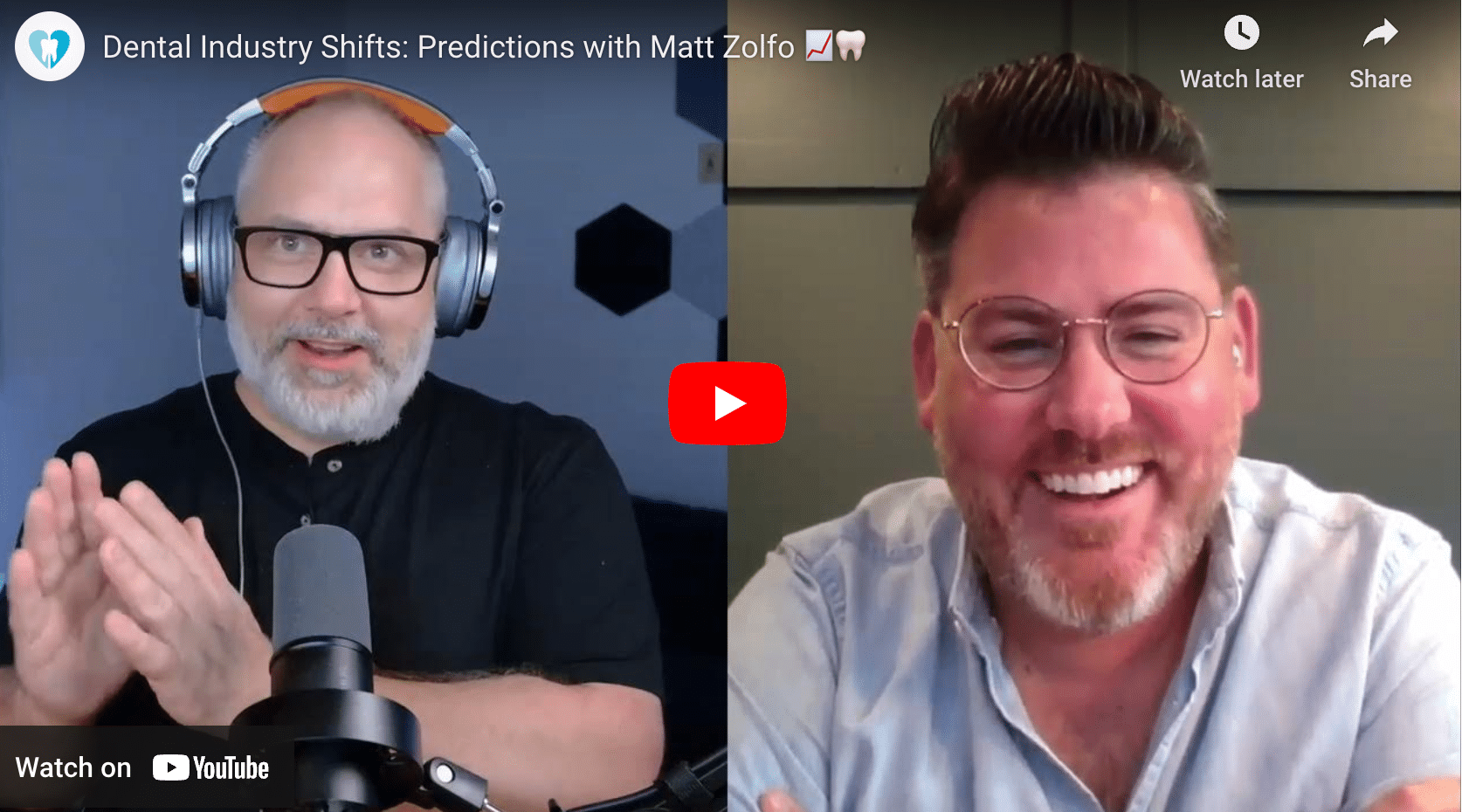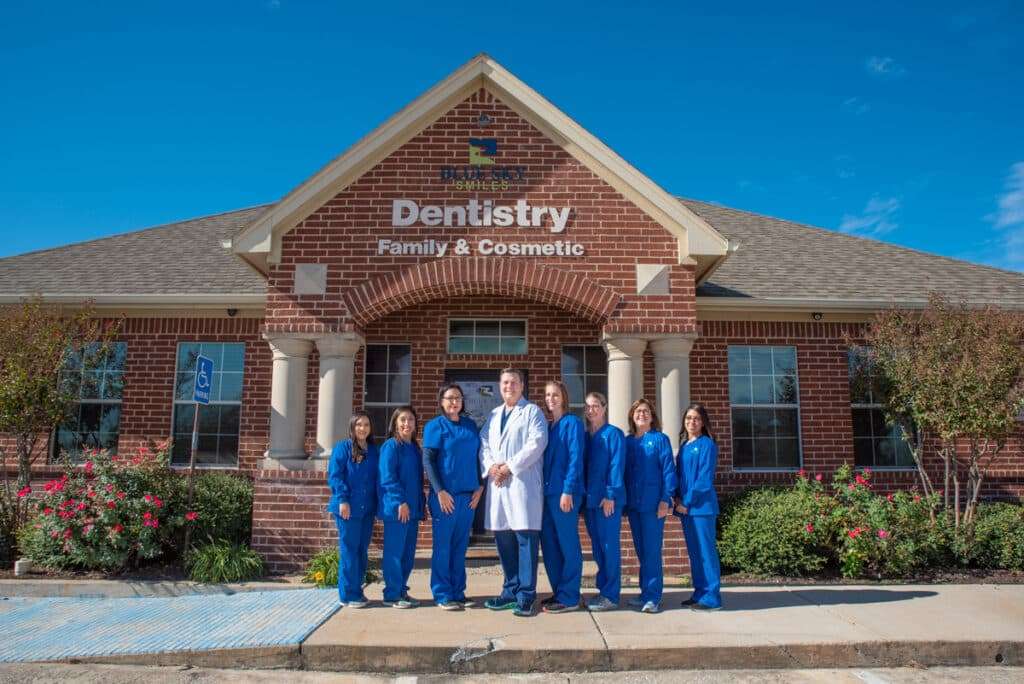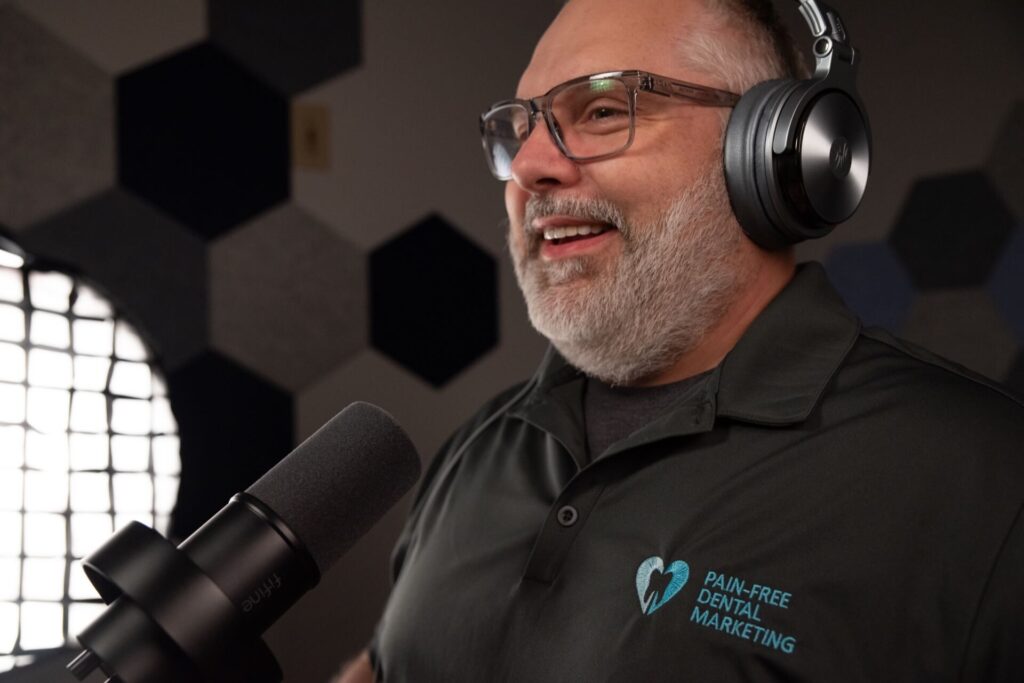Dental Industry Shifts: Predictions with Matt Zolfo
We had a fantastic conversation with Matt Zolfo about several fundamental shifts in the dental industry, outlining the changing landscape dentists are navigating. These industry shifts primarily focus on the consolidation of practices, the evolution of the business model in dental practices, and changes in workforce dynamics post-COVID. You can watch the full episode here! […]

We had a fantastic conversation with Matt Zolfo about several fundamental shifts in the dental industry, outlining the changing landscape dentists are navigating. These industry shifts primarily focus on the consolidation of practices, the evolution of the business model in dental practices, and changes in workforce dynamics post-COVID. You can watch the full episode here!
From starting with Henry Schein Dental to his current role at Professional Transition Strategies, Matt Zolfo’s journey through the dental industry provides a practical perspective on these shifts. His experience underscores a substantial move from solo practice models towards larger, consolidated groups that leverage scale to improve service delivery and profitability.
Important Industry Shifts Dentists Need To Know
- Consolidation of Dental Practices: The trend towards consolidation has been significant, with predictions suggesting that up to 70% of dental practices could be part of larger entities such as DSOs within the next decade. This mirrors trends seen in other healthcare sectors and is driven by the desire for economies of scale, better management of administrative duties, and more significant investment opportunities.
- Evolution in Dental Practice Business Models: Historically, dentists preferred owning their practices for autonomy and business control. However, newer generations of dentists are increasingly comfortable working under employment, with benefits, without the responsibilities of ownership. This shift impacts the traditional business model of dental practices.
- Workforce Dynamics and Staffing Challenges: Post-COVID, dental practices, like many other businesses, face significant challenges in staffing, particularly in finding and retaining qualified hygienists. This issue is compounded by a broader shift in work ethic and the increasing complexity of managing a healthcare practice.
Analyzing the Shifts: A Closer Look
Consolidation of Dental Practices
The dental industry is experiencing significant consolidation, with many practices joining DSOs and IDSOs. These organizations offer various benefits, such as relieving the burdens of business management, providing access to advanced technology, and alleviating financial pressures from startup costs and student debt. The entry of private equity into the dental market further accelerates this trend, with investments aimed at streamlining operations and expanding market reach.

Matt discusses the consolidation of dental practices as a significant trend, noting the movement towards larger, more organized groups, which he compares to similar consolidations in other healthcare sectors like hospitals and pharmacies. He describes how many of his early clients, who were individual practitioners, began to leave organized dentistry due to dissatisfaction with traditional models and sought to establish more autonomous practices.
However, over time, these practitioners often expanded, forming larger groups that maintained clinical autonomy while benefiting from the scale and resources of larger organizations. This consolidation trend reflects broader shifts within the industry, where dental practices increasingly become part of more extensive networks or systems offering enhanced operational efficiencies and capabilities.
Many dentists face a critical decision: continue pursuing the traditional path of practice ownership or shift towards employment within a larger group, like a DSO or IDSO. Each choice presents distinct advantages and challenges. As a dentist, you must decide what business model works best for you!
Evolution in Dental Practice Business Models
Traditionally, owning a dental practice was the standard career path for dentists. This model offered autonomy, the ability to influence practice culture and patient care directly, and financial benefits tied to owning a business. Dentists took on roles that extended beyond healthcare delivery, encompassing business operations, HR, marketing, and financial management. This model was attractive for its potential for higher earnings and the prestige associated with business ownership.

Matt discusses changes in the dental practice business model in the context of newer generations of dentists. He highlights a significant shift from the traditional model where dentists typically wanted to own their practices and have complete autonomy. He points out that the newer generation of dentists seems more inclined towards employment than owning a practice. This shift is primarily driven by desires for predictable work schedules, benefits like 401(k)s, and avoiding the complexities of running a business, which includes managing staff, handling billing, and other administrative duties.
He notes that most new dentists now prefer to perform their clinical duties within set hours and leave the administrative responsibilities to others. This illustrates a marked change from previous generations who viewed owning a practice as integral to their professional identity. This evolution affects the structure of dental practices and the expectations within the dental profession.
Workforce Dynamics and Staffing Challenges
In the rapidly evolving dental industry, workforce dynamics and staffing challenges have become increasingly prominent, particularly after the COVID-19 pandemic. These challenges are not unique to the dental sector but reflect broader trends across various healthcare fields, where shifts in worker expectations and external economic factors have profoundly impacted staffing strategies and operational dynamics.
Matt discusses the dental industry’s workforce dynamics and staffing challenges, focusing on changes that have emerged post-COVID. He broadly describes a shift in work ethic and consumer behavior that affects the industry. Zolfo points out that many of the challenges dentists face, such as staffing shortages, are similar to those faced by businesses across the United States.
Specifically, he mentions that the most significant issue is staffing, emphasizing that the situation with dental hygienists is particularly acute. He notes that about 30% of hygienists did not return to the workforce post-COVID, which has created a substantial gap in many dental offices. Additionally, he discusses the broader labor market trends, including increased labor rates due to inflation, impacting dental practices’ cost structures. This shift impacts not only the recruitment and retention of staff but also the long-term planning and operational strategies of dental practices.

Final Remarks
The shifts in the dental industry highlight significant changes in both the business models and workforce dynamics of dental practices. The move away from traditional solo practice ownership towards employment within larger groups reflects newer generations of dentists’ preferences for stability and reduced administrative burdens, indicating a fundamental shift in professional values and aspirations. Additionally, staffing challenges, particularly post-COVID, have emerged as a central concern, with a noticeable decline in the availability of dental hygienists and a broader shift in work ethics impacting practices.
These evolving trends underscore the need for dental practices to adapt to a changing landscape where business acumen, strategic partnerships, and effective workforce management are becoming critical for success. Understanding these shifts will be crucial for dental professionals aiming to thrive in an increasingly complex environment as the industry continues to consolidate and transform.
Looking For More Dental Industry Insights?
Bite-Sized Dental Marketing is a podcast that discusses the most important topics in the dental industry and dental marketing. You can view our channel here!
